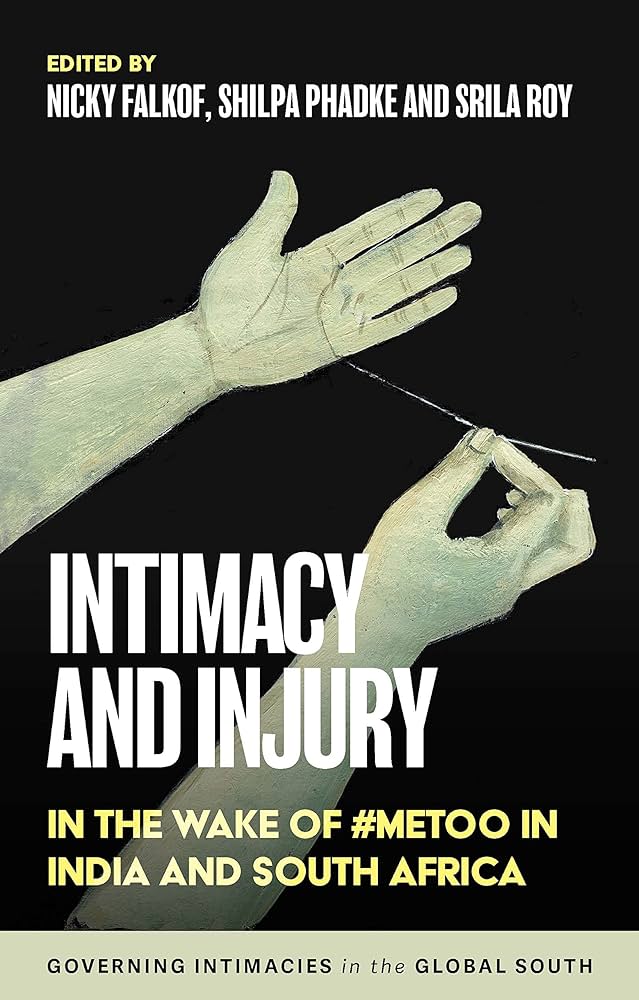
Intimacy and Injury: In the wake of #MeToo in India and South Africa edited by Nicky Falkof, Shilpa Phadke and Srila Roy and published by Manchester University Press in 2022 is a fine collection of essays that challenges the assumption that movements like #MeToo have seamlessly transferred to the Global South. In a well-organized manner, the book offers a critical exploration of feminist organizing in India and South Africa dissecting the complexities of gender politics, sexual violence, and social hierarchies. It features contributions from marginalized voices and people of colour. This diversity of viewpoints provides a much-needed counter-narrative to the dominant discourse surrounding movements like #MeToo. By refuting the claim that #MeToo has travelled to the Global South, the book suggests the need for a radical re-imagining of the raced, classed gender politics of sexual violence at the scalar level and offers a different perspective “from the margins.”
Intimacy and Injury is a vital addition to the ongoing discussions about gender politics, sexual violence, and feminist organizing. It challenges preconceived notions and calls for a more inclusive and nuanced approach to addressing these pressing issues. The origins of this book lie in a transformative workshop hosted at Wits University, bearing the same title. The book is divided into four sections, with thirteen chapters. The first half of the book offers a rich tapestry of topics placing the #MeToo movement at the centre of the discussion. It delves deep into the complex history of global resistance movements both in India and South Africa, the changing media landscape, the digitalization of media that has opened unstable and implausible narratives, the complexities of sexual politics, and the pressing issue of caste-based sexual violence and concludes with how the internet has reconfigured feminism.
The second half of the book focuses on the experiences of individuals who have been deeply affected by gender-based violence in both India and South Africa. Their narratives and their dedication to activism underscore the significance of recognizing Queer feminism as an integral aspect of feminism. Moreover, this part of the book puts the spotlight on the disturbing prevalence of misogyny and the objectification of women’s bodies in advertising and television programs.
A myriad of perspectives and events are discussed in the book. In her chapter, Rupali Bansode documents the life of Satayabhama and her unconventional strength in fighting her rapists. Jessica Breakey tells her own story of survival. Such stories leave us besieged but at the same time, their courage gives hope. The book brings some intense moments regarding queer feminism. How Queer people think about their bodies, their sexual encounters? What would consent mean when you are a queer? Jamil F Khan’s story leaves one with all these questions and focuses on insecurities about the body, sexual unawareness, consent within the Queer community, the idea of rape and how it manifests. Jamil’s story serves as a poignant reminder of the importance of a more inclusive approach to feminism, urging us to broaden our understanding.
Although the MeToo movement takes centre stage in this book, serving as a focal point for in-depth discussions, the book dissects the movement’s intricacies and challenges. In her chapter, Swati Arora argues that MeToo highlighted the widespread misogyny and racism in everyday life (309). Another aspect of the movement that the book captures is that despite its failure to address the issues of women of colour, marginalized like the poor, Dalit, Bahujans and the Adivasis, and the queer, the movement, as Amanda Gouws in her chapter argues, changed the ways we think sexual harassment, victim blaming or consent. These reflections are important as it shows the nature of the movement both in India as well as in South Africa.
The book’s central argument—that MeToo has not simply transplanted itself into the Global South—forces readers to confront the limitations of a one-size-fits-all approach to feminist movements. This diversity of perspectives offers a much-needed counter-narrative to the dominant discourse surrounding movements like MeToo. The essays within the collection are incisive and provide a deep understanding of the nuances and challenges faced by marginalized communities in these regions. It is important to understand that feminism in the context of India and South Africa has failed to tackle the issues of sexual harassment when faced by the most marginalized sections of their society.
As Amia Srinivasan says, “Feminism must ask women to be better, more imaginative.” I think this book does justice to how one can be more imaginative or maybe better. This book is a captivating examination of the global #MeToo movement that provides an in-depth study of its journeys through South Africa and India. The book adds to the current global conversation about feminism, gender-based violence, and the complexity of cultural contexts. It offers a special chance to consider the effectiveness of group efforts and the variety of approaches that can be used to address the pervasive problem of sexual violence. At the same time, it may not be an easy read for those unfamiliar with academic discourse. Some essays are highly theoretical and may require a solid background in feminist studies to fully grasp. However, the editors have done an excellent job of curating a diverse selection of essays that balance theoretical rigour with accessible language.
***
Sabeeha Shaheen is a doctoral candidate at the Marie Jahoda Centre for International Gender Studies, Ruhr University Bochum, Germany.
[…] post Intimacy and Injury: In the wake of #MeToo in India and South Africa edited by Nicky Falkof, Shilpa … appeared first on Doing […]